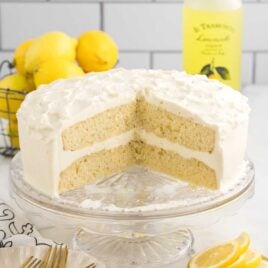Limoncello Cake
Limoncello cake is a dessert brimming with the flavor of lemon, featuring layers of moist cake complemented by a creamy mascarpone frosting.
Servings: 10
Calories: 835kcal
Ingredients
Limoncello Cake
- 2¾ cups all-purpose flour
- 2 teaspoons baking powder
- ½ teaspoon baking soda
- ½ teaspoon salt
- ¾ cup unsalted butter, softened to room temperature
- 1½ cups granulated sugar
- 3 large eggs, room temperature
- ¾ cup whole milk, room temperature
- 2 teaspoons fresh lemon zest
- ¼ cup fresh squeezed lemon juice
- 3 ounces limoncello lemon-flavored liqueur
Mascarpone Frosting
- 12 ounces mascarpone cheese, room temperature
- 1½ cups powdered sugar, sifted
- 1½ teaspoons lemon extract
- 1½ teaspoons vanilla extract
- 2¼ cups heavy whipping cream, very cold
Optional Garnish
- fresh lemon circle, thinly sliced sliced in the center and twisted
Instructions
- Preheat oven to 350°F. Spray two (9-inch) round cake pans with baker’s spray and line the bottom of each pan with a parchment round. Set aside.
- In a medium bowl, stir together the all-purpose flour, baking powder, baking soda, and salt.
- In a large mixing bowl, cream together, using a handheld mixer on medium speed, the room temperature butter and granulated sugar for 1-2 minutes or until light and fluffy.
- With the mixer on low, add the eggs, one at a time, being sure to fully incorporate each egg before adding the next. Scrape the sides and bottom of the bowl if needed to ensure that all the ingredients are fully incorporated.
- Add the room temperature whole milk, lemon zest, freshly squeezed lemon juice, and limoncello liqueur to a bowl with a pour spout (a two-cup liquid measure cup works well). Stir to combine.
- Add a third of the dry ingredients to the mixing bowl. Beat on low just until the flour is incorporated. Next, add half the milk mixture, followed by another third of the flour mixture, the remaining milk mixture, and lastly, the remaining flour mixture. Be sure that you are mixing in each addition just until fully incorporated. Do not overmix your batter, or your cake will be tough. Your batter will be slightly thick.
- Divide the batter equally between the two prepared round cake pans. Gently spread the batter into an even layer. A small offset spatula works well for this. Bake for 22-25 minutes or until lightly golden around the edges and a toothpick inserted into the center of the cake comes out clean.
- Allow the limoncello cake to cool in the pans for 10 minutes before carefully flipping them out onto a wire rack to cool completely. Be sure to remove the parchment paper from the bottoms of each cake once they are flipped onto the cooling rack.
- Once your cake has cooled, you can make the mascarpone frosting by adding the room temperature mascarpone cheese, sifted powdered sugar, lemon extract, and vanilla extract to the bowl of a stand mixer fitted with the whisk attachment and beat on medium-high speed until smooth. This should take 1-2 minutes. Scrape down the sides and bottom of the bowl.
- With the mixer running on low speed, slowly pour the cold whipping cream into the bowl until all the cream is incorporated into the mascarpone cheese. Gradually increase the speed of the mixer to high and beat the mascarpone frosting for 2-3 minutes or until stiff peaks form. Be sure not to over-mix, or your frosting will start to break down and separate.
- To frost the cake, place the first layer of limoncello cake onto a cake plate, add a third of the mascarpone frosting to the cake, and spread it into an even layer. This layer should be nice and thick. Place the second cake layer onto the frosted layer, then frost the sides and top of the cake. Garnish with the thinly sliced lemon circle if desired.
Notes
- Be sure that all of your cake ingredients are at room temperature before adding them to the batter. This helps to ensure that your cake rises and bakes up evenly. Your heavy whipping cream is the only ingredient that should be very cold.
- When combining the wet and dry ingredients, be careful not to overmix the batter. Overmixing can lead to a tougher cake. Mix just until the ingredients are fully incorporated.
- Oven temperatures vary and may need to be recalibrated periodically to ensure they are accurate. Make sure to keep a close eye on your cake as the suggested baking time approaches.
Nutrition
Calories: 835kcal | Carbohydrates: 81g | Protein: 10g | Fat: 51g | Saturated Fat: 31g | Polyunsaturated Fat: 2g | Monounsaturated Fat: 9g | Trans Fat: 1g | Cholesterol: 189mg | Sodium: 236mg | Potassium: 229mg | Fiber: 1g | Sugar: 54g | Vitamin A: 1800IU | Vitamin C: 3mg | Calcium: 159mg | Iron: 2mg
